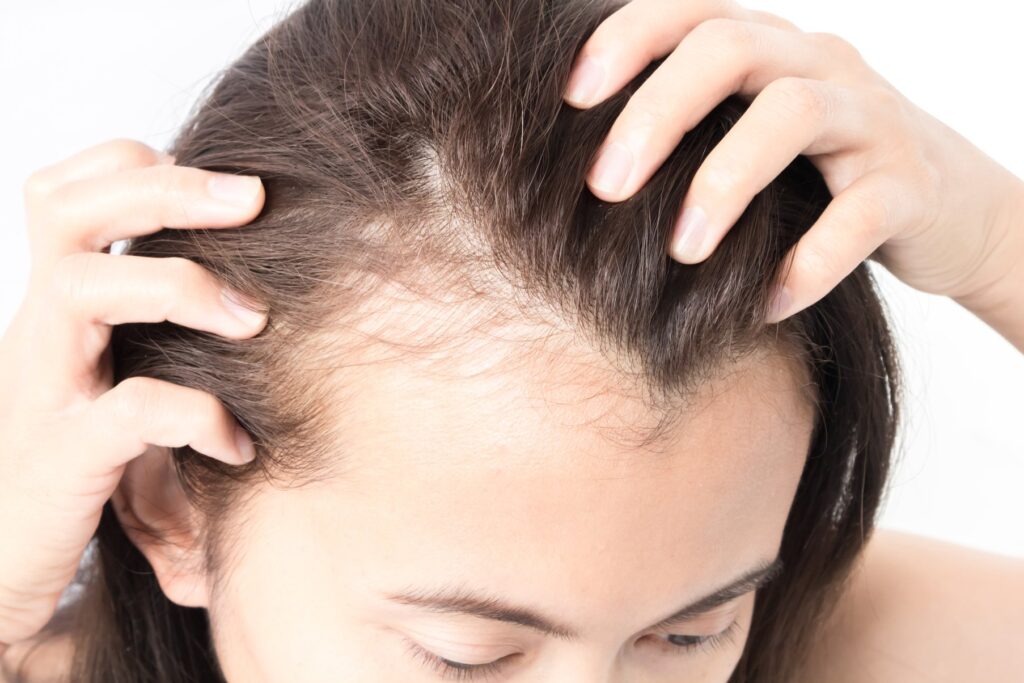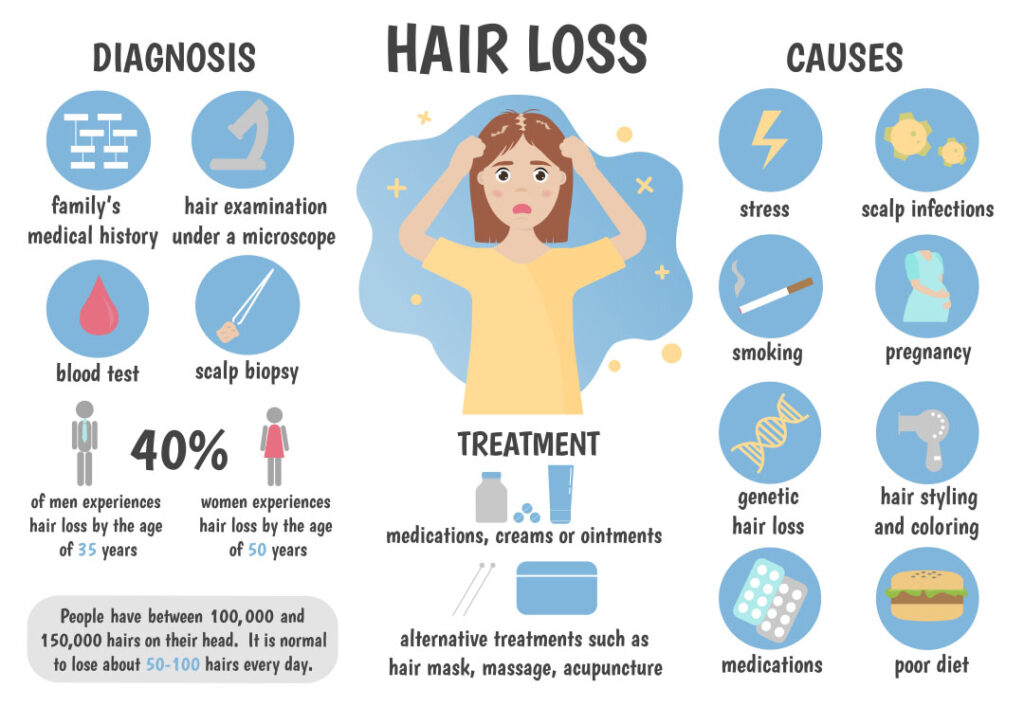Hair Conditions
ALOPECIA (a loss of hair) and HIRSUTISM (having unwanted hair) are two common hair conditions for which patients seek help.

What is alopecia?
Alopecia is a term that means hair loss and is an autoimmune disease. This condition can be spread across the body or localized to one area and has the possibility of scarring.
What causes alopecia?
- Genetics: Individuals who have a close family member with Alopecia have a higher likelihood of having this autoimmune disease.
- Telogen Effluvium: This type of hair loss usually occurs two to six months after a major life event such as childbirth, weight loss, illnesses and psychological stress.
- Alopecia Areata: This hair loss condition develops when the body’s immune system attacks its own hair follicles and creates hair loss patches.
- Hormonal imbalance: Individuals who have polycystic ovary syndrome (PCOS) may experience hair loss, along with cysts on the ovaries and other symptoms.
- Scalp infection: Scalp infections lead to scaly and inflamed areas. This can lead to hair loss.
- Trichotillomania: This type of hair condition is caused by self-induced pulling of the hair.
- Inflammatory skin conditions: Conditions such as psoriasis, eczema and seborrheic dermatitis can lead to temporary hair loss.
- Medications: Individuals who have to undergo chemotherapy can experience hair loss.
- Systemic diseases: Those who have iron deficiencies, thyroid disease or lupus may experience hair loss.
What are the symptoms of alopecia?
The symptoms you may have can depend on what is causing the hair loss, including:
- Gradual thinning of the hair: This is associated with male and female pattern baldness.
- Sudden hair loss in patches: This symptom is seen in alopecia areata.
- Pain and itching: This could occur if you have an infection or an inflammatory skin condition.
- Scaly patches: Usually seen with psoriasis and lupus.
How is alopecia diagnosed?
To diagnose the type of Alopecia you have and what is causing it, your dermatologist will begin by gathering information. Your dermatologist may ask a series of questions about your medical history, stress levels and home life.
If your dermatologist suspects that your hair loss could be caused by a systemic disease, hormone imbalance or infection, they may order blood tests or a scalp biopsy.

How is alopecia treated?
Treatment is unique and is based on the cause of hair loss.
- Infections should be treated.
- Deficiencies should be remedied.
- Causative drugs may be discontinued.
- Inflammation can be suppressed.
For androgenetic alopecia (AKA female and male pattern baldness) at home remedies include:
- Minoxidil (Rogaine): This medication is an over the counter medication for men and women, and has to be applied daily for benefits to occur. This type of treatment usually takes six months to prevent hair loss and encourage hair regrowth.
- Nutrafol and Viviscal: These are vitamins and minerals that have been proven to help with hair loss.
Prescription medications include:
- Finasteride (Propecia): This medication is used for men and women in menopause and is taken daily. It can slow hair loss and encourage hair regrowth.
- Spironolactone: This medication is typically used for women that have hormonal changes causing hair loss. This prescription can not be used during pregnancy and is typically prescribed with birth control pills.
- Botulinum toxin injection: This is a non-FDA approved injections of botulinum toxin in men with male pattern hair loss throughout the scalp. The theory is that by relaxing the scalp muscles, there is an increase in oxygenation, which decreases the hormones involved in hair loss. Unfortunately, very few small studies have been performed, but they have shown some benefit.
For alopecia areata, medications can be used to slow or stop the immune disease causing hair loss. Medications could include:
- Topical steroids: These medications can be prescribed in a liquid, gel, foam, lotion or cream to apply to bald areas.
- Steroid injections: This procedure has to be performed by a dermatologist every four to eight weeks.
- Anthralin: This medication is applied directly to balding spots and will sit on the skin for a recommended amount of time. Then, your dermatologist will wash the medication off. This can cause irritation, which stimulates hair regrowth.
- Minoxidil (Rogaine): This medication is an over the counter medication for men and women, and has to be applied two to three times daily for benefits to occur. This type of treatment usually takes six months to prevent hair loss and encourage hair regrowth. Additionally, you may need to use this with other treatments.
What is hirsutism?
Hirsutism is a condition in women, resulting in the growth of dark or coarse hair on the face and body similar to a male pattern hair growth such as the beard and mustache area.
What causes hirsutism?
In general, hirsutism in women is caused by overstimulation of the hair follicle by testosterone and other androgen hormones. Androgens are the dominant sex hormones in men, yet they should be found at low levels in women. If androgens are elevated in women, they will experience unwanted hair.
Here is a list of medical conditions/medications that result in unwanted hair:
Polycystic ovary syndrome (PCOS): This syndrome often occurs during puberty if there is an imbalance of sex hormones due to cysts’ growth on the ovaries. It can result in excessive hair growth, acne, irregular periods, weight gain, and infertility.
Cushing Syndrome: This syndrome could occur when the adrenal gland produces too much cortisol or if you are taking too much prednisone for extended periods, which can stimulate unwanted hair growth.
Congenital adrenal hyperplasia: This is a hereditary condition when an individual produces too much cortisol and androgen(male hormone), which stimulate unwanted hair growth.
Tumors: Rarely, an androgen-secreting tumor in the ovaries or adrenal glands can cause Hirsutism.
Medications: Additionally, there are common medications that can result in unwanted hair, including:
- Minoxidil or Rogaine
- Danazol which is used to treat women with endometriosis
- Testosterone supplements
- Dehydroepiandrosterone (DHEA) supplements
Idiopathic: This term is used when there is no identifiable cause of unwanted hair.
What are common risk factors for hirsutism?
- Family history: Hereditary conditions like PCOS and adrenal hyperplasia can cause unwanted hair.
- Ancestry: Women of Mediterranean, Middle Eastern and South Asian descent are more likely to have an excess of body hair with no cause compared to other women.
- Obesity: Being overweight causes increased androgen (male hormone) production, which can worsen hair gain in unwanted areas.
How can I prevent unwanted hair?
Hirsutism generally isn’t preventable. However, if certain medications are causing it, those could be evaluated and changed by your physician.
How is hirsutism diagnosed?
To diagnose Hirsutism, your dermatologist will ask you a series of questions to identify:
- Family history of abnormal hair growth
- Menstrual cycle history
- Medication that may cause unwanted hair growth
Your dermatologist may also recommend blood tests to determine if you have high levels of testosterone-like hormones.
What is the treatment for hirsutism?
Treatment is based on the cause of unwanted hair. Treatment can be placed into two categories:
Medications: When using medications, it can take up to six months before you see a significant difference in hair growth. Your options include:
- Oral contraceptives: Birth control pills treat Hirsutism caused by androgen production.
- Anti-androgens: These drugs block androgens from attaching to receptors in your body. Spironolactone is the most commonly used anti-androgen. It may be used in conjunction with spironolactone if desired results are not reached.
- Topical cream: Vaniqa is a prescription cream specifically for excessive facial hair in women. It is applied twice a day to help slow new hair growth but doesn’t get rid of existing hair. It can be used with laser therapy to have a more desirable response.
Procedures: In-office hair removal methods whose results last longer than self-care methods include:
- Laser hair removal: A laser beam is passed over affected areas to damage hair follicles and prevent hair from growing. This usually requires multiple treatments. Laser treatments are appropriate for unwanted hair that is black, brown or auburn.
- Electrolysis: After a numbing cream is applied, a tiny needle is inserted into each hair follicle. The needle emits a pulse of electric current to damage and destroy the follicle. This might require multiple treatments. Patients with naturally blond or white hair, electrolysis typically experience better results with electrolysis than laser treatments.
What are some home remedies?
Self-care methods such as plucking, shaving, waxing, bleaching, and chemical depilatories are temporary ways of removing unwanted hair. While these are all effective treatments for mild hirsutism, they can irritate the skin and be repeated for continued success.
How can my dermatologist help?
Patients often experience embarrassment and anxiety as a result of their alopecia or hirsutism. The psychological effects can impact social lives and in extreme cases, even employment. Treatment of alopecia or hirsutism usually leads to a significant improvement in self-esteem.
Our staff is dedicated to keeping up-to-date with the most advanced procedures and patient education. If you are experiencing alopecia or hirsutism and would like a consultation, please contact us.
Dermatology Center for Skin Health, PLLC
600 Suncrest Towne Centre, Suite 115
Morgantown, WV 26505
Our office is located on the ground floor of the 600 Suncrest Towne Centre Building. Please enter through the middle doors at the front of the building. The Dermatology Center for Skin Health, PLLC entrance is located just inside the building — first door on the right.
You can also text us to make an appointment.
To communicate with us from a mobile phone, click the button below or send a text to the number.

